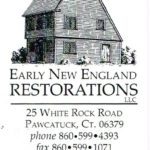By HHA Member Tom Helmer
In modern construction, interiors are finished with sheet rock, exterior stonework is held together with concrete. These products have one thing in common: you buy them. They are available “Off The Shelf” at most building supply stores.
Our historical ancestors, living in the 17th and 18th centuries, also had one common way to deal with these same problems: you make your own.
Along the costal waters of “The New World”, the practice of making plaster, which could be transformed into mortar for stone or brick usage by adding sand, was well known and common. Today it is a lost art.
But Brian Cooper, of Early New England Restorations, Pawcatuck, CT, is constructing an authentic 18th century reproduction for the Pendelton – Chapman House, at 2 Avondale Road, Avondale, RI.
This is a meticulous project, requiring Brian to use his decades of experience as the owner of Early New England Restorations, but going deeper into history. Instead of using re-purposed colonial bricks and glass, of which he has an extensive supply, this job requires him to make his own plaster, bricks and glass using the authentic methods of the 1700’s.
BACKGROUND
The first problem is the most obvious: Who would know how to DO such a thing?
The answer was equally obvious: The curators of the walk through museum at Williamsburg, VA.
The following information and pictures are derived from their website: colonialwillamsburg.com
This video will give you an overview of the work Early New England Restorations will be undertaking during 2013, 2014 & possibly beyond.
What follows is a slide show of the February 14 & 15, 2009 Oyster Shell Burn at Williamsburg, VA. The text is derived from Williamsburg & Joshua Grami, the pictures are by Jessica Krop & Peter Inker
Lime was vital to many building trades in the 18th century. To obtain lime, oyster or clam shells were burned in a “Rick”, an open air wood pile constructed specifically for this purpose. Wood was stacked up in a circular form which allowed air to penetrate to the center of the Rick. There was a tower of sticks and kindling which served as the wick for lighting the firewood of the Rick so it would burn from the center out.
After the Rick was constructed to about 4 feet tall, oyster shells were piled up in a mammoth heap atop the wood, till they slid off the slope. The central wick was ignited, burned itself down to the center of the Rick, and the physics of combustion tool over for the next 24 to 48 hours.
After the Rick cooled, the burned shells were collected in smaller amounts within a bucket, and warm water was poured over them. The burned shells, now “Lime”, chemically different than an unburnt oyster shell, react instantly to the presence of the water, giving off enough heat to instantly make the water boil.
This new chemical is called Slacked Lime. This is what will become the Plaster or Mortar after it sits, hydrating underwater for 6 months. The Slacked Lime is scraped through a screen into a “Lime Pit”, the screen removing the bigger impurities. During the 6 months of sitting underwater, many of the other impurities settle to the bottom of the Lime Pit.
When it was time to use the Slacked Lime as Plaster or Mortar, the quantity you needed was removed from the Lime Pit, and the finer components needed to make plaster of the desired texture were added, or the coarser components, like sand, were added to make the Slaked Lime into stone or brick mortar.
Colonial Plaster had to be stored underwater to prevent it from curing into Plaster or Mortar.
Chemically, Colonial Slaked Lime had to combine with C02, and excrete it’s H20 to harden
Modern Plaster requires water to be absorbed to produce the chemical reaction which hardens into plaster.
Reminder, the pictures below are courtesy of Williamsburg, VA. This burn took place 2/14/09
You are invited to see the Avondale Oyster Shell Burn, 2013
Beginning the evening of October 31 through the day of November 1, 2013, the public is invited to view what may be the first Rhode Island “Oyster Shell Burn” in nearly two centuries, as well as tour the historic “Avondale Barn” project at 2 Avondale Road, Avondale, RI.
 For more information, please call Early New England Restorations, (860) 599 4393.
For more information, please call Early New England Restorations, (860) 599 4393.
Their fax and e mail address is included on the business card
This page will expand as HHA covers the Avondale Oyster Shell Burn, from preparing the Rick, the actual burn, the Slacking, Storage and eventual use in the historic Pendelton – Chapman House Project.
Your Invitation to Witness History In The Re-Making…
11/2/2013 The Avondale Lime Burn
By Early New England Restorations
Bad weather delayed the burning of the 10 cords of wood, bearing 3,500 pounds of Oyster Shells until Saturday morning @ 9:00. You will find four different slide shows recording the burn and those who came out to see History in the Re-Making, as well as two videos from shortly after the “Fuse” was lit, (sticks and kindling in the center of the Rick), and one video at the height of the burn.
The initial videos record the sound of the “steam popping” of the wood within the core as the heat builds up. No one expected this sound, but it was very loud, and not that surprising after a few moments of thought. You hear it with a small camp fire. With 10 cords of wood ignighting at once, the “Pops” were very frequent!
One of the slide shows also has photos within the historic barn. Later, the page will be expanded to show more of the barn and the construction of the Rick.
All pictures and videos were taken by HHA Member Tom Helmer.



